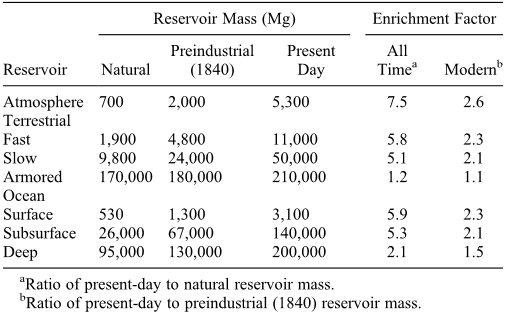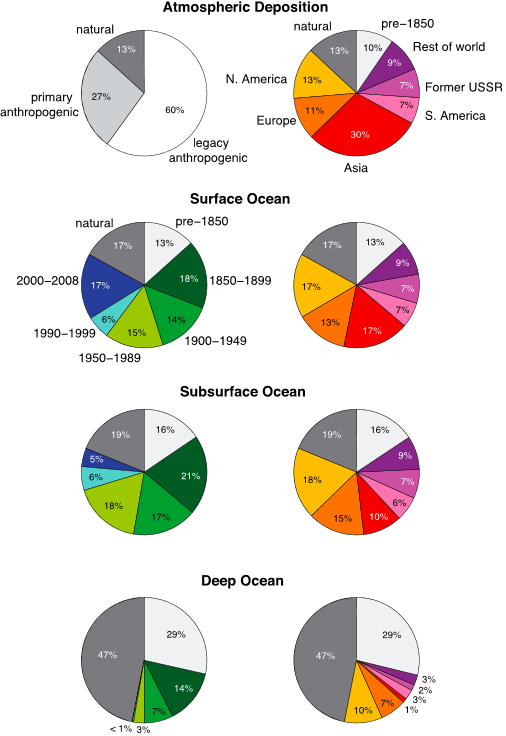Legacy impacts of all‐time anthropogenic emissions on the global mercury cycle
Reads0
Chats0
TLDR
In this article, a global biogeochemical model with fully coupled atmospheric, terrestrial, and oceanic Hg reservoirs is presented to better understand human influence on Hg cycling and timescales for responses.Abstract:
[1] Elevated mercury (Hg) in marine and terrestrial ecosystems is a global health concern because of the formation of toxic methylmercury. Humans have emitted Hg to the atmosphere for millennia, and this Hg has deposited and accumulated into ecosystems globally. Here we present a global biogeochemical model with fully coupled atmospheric, terrestrial, and oceanic Hg reservoirs to better understand human influence on Hg cycling and timescales for responses. We drive the model with a historical inventory of anthropogenic emissions from 2000 BC to present. Results show that anthropogenic perturbations introduced to surface reservoirs (atmosphere, ocean, or terrestrial) accumulate and persist in the subsurface ocean for decades to centuries. The simulated present-day atmosphere is enriched by a factor of 2.6 relative to 1840 levels, consistent with sediment archives, and by a factor of 7.5 relative to natural levels (2000 BC). Legacy anthropogenic Hg re-emitted from surface reservoirs accounts for 60% of present-day atmospheric deposition, compared to 27% from primary anthropogenic emissions, and 13% from natural sources. We find that only 17% of the present-day Hg in the surface ocean is natural and that half of its anthropogenic enrichment originates from pre-1950 emissions. Although Asia is presently the dominant contributor to primary anthropogenic emissions, only 17% of the surface ocean reservoir is of Asian anthropogenic origin, as compared to 30% of North American and European origin. The accumulated burden of legacy anthropogenic Hg means that future deposition will increase even if primary anthropogenic emissions are held constant. Aggressive global Hg emission reductions will be necessary just to maintain oceanic Hg concentrations at present levels.read more
Figures

Table 2. Hg Reservoir Masses and Historical Anthropogenic Enrichments 
Figure 3. Simulated present-day global Hg budget and all-time anthropogenic enrichments factors. Terrestrial-atmosphere exchange is given in the top panel for the sum of terrestrial reservoirs. The bottom panel shows the breakdown and cycling between the different terrestrial reservoirs. All terrestrial reservoirs receive inputs from Hg(II) deposition (fast = 800, slow= 510, and armored = 280Mg a 1). The fast reservoir also receives inputs from Hg(0) deposition (1600Mg a 1). All terrestrial reservoirs lose Hg through respiration (fast = 520, slow= 360, and armored =30Mg a 1) and biomass burning (fast = 320, slow = 9, and armored = 5Mg a 1). Photoreduction from the fast terrestrial reservoir is 950Mg a 1. 
Table 1. Present-Day Hg Reservoirs and Flowsa 
Figure 8. Change in reservoir masses relative to 2015 under a scenario of zero primary anthropogenic emissions after 2015. 
Figure 7. Natural and anthropogenic contributions to present-day atmospheric deposition and ocean reservoirs. The contribution from natural Hg is defined by steady state in our biogeochemical model without anthropogenic emissions. The primary anthropogenic contribution to deposition is from direct emissions (Figure 2a), while the legacy contribution is from anthropogenic Hg previously deposited and then re-emitted by surface reservoirs. The contribution from legacy Hg is calculated as total deposition minus primary anthropogenic emissions and natural emissions. For the ocean reservoirs, we partition the anthropogenic contribution by time period (left column) and region (right column). “Rest of world” includes Africa, the Middle East, and Oceania. 
Figure 1. Rate coefficients kij (a 1) driving our sevenreservoir global biogeochemical box model for Hg. kij defines the first-order transfer from reservoir i to reservoir j as Fij = kijmi, where Fij (Mg a 1) is the Hg flow from reservoir i to reservoir j and mi (Mg) is the mass of Hg in reservoir i. Values of kij are derived from best estimates of present-day flows andmasses from the literature (Table 1) and are assumed to be constant in time. The red arrow represents the external forcing by primary emissions (geogenic or anthropogenic) from the deep mineral reservoir. Geogenic emissions are constant (90Mg a 1), and anthropogenic emissions are time dependent (Figure 2).
Citations
More filters
Book ChapterDOI
Past, Present, and Future of Mercury Pollution Issues
TL;DR: In this paper, countermeasures and solutions to methylmercury poisoning (MPM) and current and outstanding issues on the mercury pollution are discussed, which are necessary for preventing the similar kind of pollution and human hazard.
Journal ArticleDOI
Atmospheric mercury in the Latrobe Valley, Australia: Case study June 2013
Robyn Schofield,Steven Utembe,Steven Utembe,Caitlin M. Gionfriddo,Caitlin M. Gionfriddo,Michael T. Tate,David P. Krabbenhoft,Samuel B O Adeloju,Samuel B O Adeloju,Melita Keywood,Melita Keywood,Roger Dargaville,Roger Dargaville,Mike Sandiford +13 more
TL;DR: Gaseous elemental mercury observations were conducted at Churchill, Victoria, in Australia from April to July, 2013, using a Tekran 2537 analyzer, and the results indicated that long-term air and soil sampling in power generation regions, even after the closure of coal fired power stations, will have important implications to understand the airborne mercury emissions sources.
Journal ArticleDOI
Mercury Isotope Variations in Lake Sediment Cores in Response to Direct Mercury Emissions from Non-Ferrous Metal Smelters and Legacy Mercury Remobilization.
TL;DR: The authors measured Hg isotope compositions in three dated sediment cores at different distances from the Flin Flon smelter, the largest Canadian Hg sources to the atmosphere during the 1930s-2000s.
Journal ArticleDOI
Planular-vertical distribution and pollution characteristics of cropland soil Hg and the estimated soil–air exchange fluxes of gaseous Hg over croplands in northern China
TL;DR: Wang et al. as mentioned in this paper evaluated the role of cropland in the global soil-air exchange of Hg based on simulation experiments and regional survey, and found that the topsoil Hg concentration was significantly higher than those in deeper layers at most of sites, indicating the more serious pollution situation in recent years.
Journal ArticleDOI
Variation characteristics and source differences of gaseous elemental mercury over four seasons in Qingdao: Influence of weather processes
TL;DR: In this paper, the variation characteristics and sources of gaseous elemental mercury (GEM) and other pollutants were studied in typical air pollution processes throughout four seasons in the East Asian Monsoon Region.
References
More filters
Journal ArticleDOI
Terrestrial ecosystem production: A process model based on global satellite and surface data
Christopher S. Potter,James T. Randerson,Christopher B. Field,Pamela A. Matson,Peter M. Vitousek,Harold A. Mooney,Steven Klooster +6 more
TL;DR: In this paper, the authors present a modeling approach aimed at seasonal resolution of global climatic and edaphic controls on patterns of terrestrial ecosystem production and soil microbial respiration using satellite imagery (Advanced Very High Resolution Radiometer and International Satellite Cloud Climatology Project solar radiation), along with historical climate (monthly temperature and precipitation) and soil attributes (texture, C and N contents) from global (1°) data sets as model inputs.
Journal ArticleDOI
Mixed layer depth over the global ocean: An examination of profile data and a profile-based climatology
TL;DR: In this paper, a 2° resolution global climatology of the mixed layer depth (MLD) based on individual profiles is constructed and a new global seasonal estimation of barrier layer thickness is also provided.
Journal ArticleDOI
Global mercury emissions to the atmosphere from anthropogenic and natural sources
Nicola Pirrone,Sergio Cinnirella,Xinbin Feng,R. B. Finkelman,Hans R. Friedli,Joy J. Leaner,Robert P. Mason,Arun B. Mukherjee,Glenn B. Stracher,David G. Streets,Kevin Telmer +10 more
TL;DR: In this paper, the authors provided an up-to-date assessment of global mercury emissions from anthropogenic and natural sources, including re-emission processes and primary emissions from natural reservoirs.
Journal ArticleDOI
The biogeochemical cycling of elemental mercury: Anthropogenic influences☆
TL;DR: A review of the available information on global Hg cycling shows that the atmosphere and surface ocean are in rapid equilibrium; the evasion of Hg0 from the oceans is balanced by the total oceanic deposition of hg(II) from the atmosphere as mentioned in this paper.
Journal ArticleDOI
The Case for Atmospheric Mercury Contamination in Remote Areas
TL;DR: A review of the weaknesses in interpretation and the choice of information that has been used to argue against atmospheric Hg contamination can be found in this paper, where the authors examine the weaknesses of the information used to support the prevailing scientific view that natural geologic sources are the principal contributors of Hg.